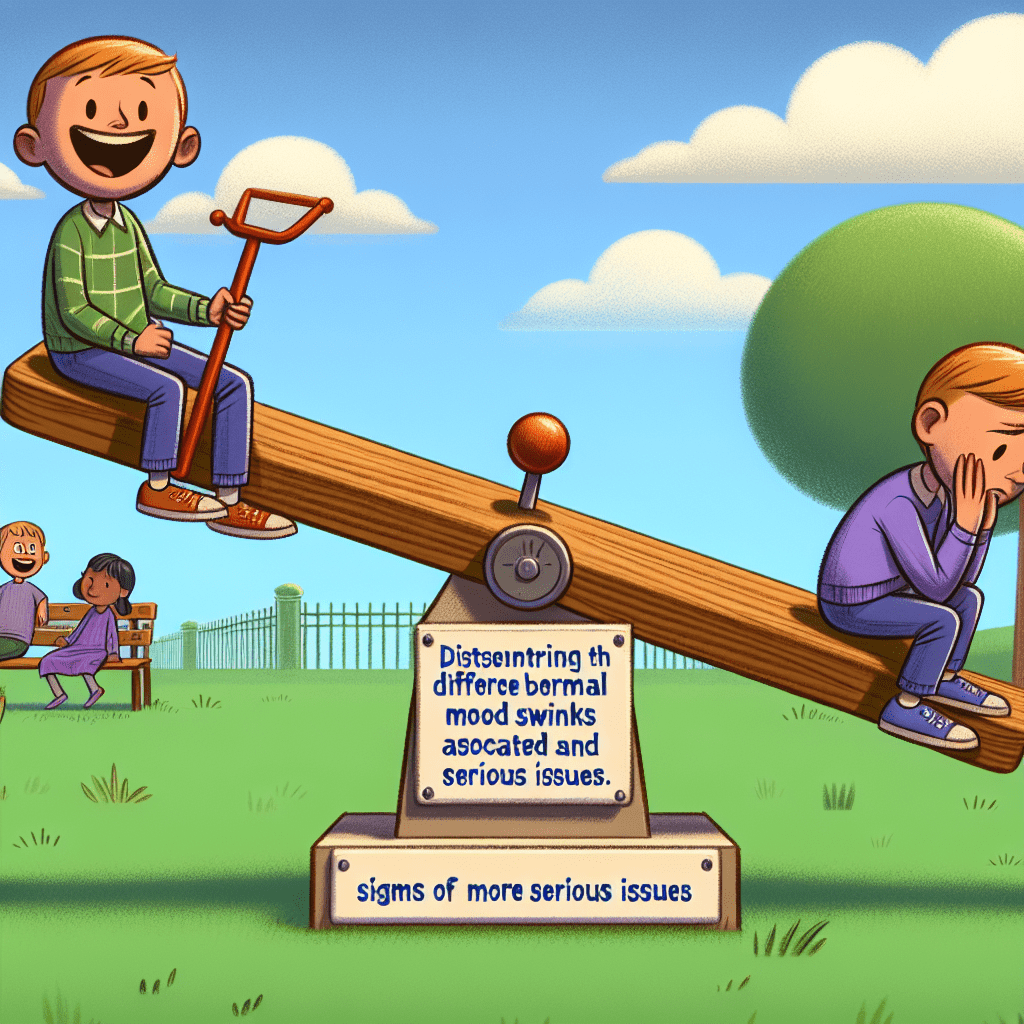Get your free Book Here

Understanding the Signs: When Are Mood Swings Just Normal Childhood Ups and Downs?
As life unfolds, one of the most fascinating yet perplexing phenomena we witness is the emotional landscape of children. Just like the weather, moods can change quickly, often leaving parents and caregivers scrambling to decipher the clouds hiding their child’s inner sun. Are these emotional shifts a normal part of growing up, or do they suggest something deeper is at play? Understanding the signs can provide clarity in what is often a confusing time. In today’s blog post, we will explore this topic in-depth, equipping you with insights to navigate the ups and downs of childhood moods.
1. The Nature of Mood Swings
Children, much like adults, experience mood changes every day. However, the frequency and intensity of these swings can vary significantly. Mood swings in children can manifest in several ways, including irritability, sadness, excitement, or even bursts of anger. But what is important to understand is that while these mood changes may be unsettling, they are often an integral part of your child’s developmental stages.
Children are constantly learning how to express their emotions. From the toddler who throws a tantrum over a toy to the preteen who sulks in silence, each behavioral response reflects their struggle to understand their feelings and communicate them effectively. These fluctuations in temperament can be explained, in part, by their developing brains, which are still learning how to regulate emotions.
2. Common Triggers of Mood Swings
Almost every child experiences mood swings, but specific triggers can exacerbate these emotional fluctuations. These triggers often include:
-
Social Interactions: Friendships can be a rollercoaster ride of emotions. From the joy of playdates to the sting of exclusion, social dynamics have a significant impact on how children feel.
-
School Stress: Academic pressures, peer relationships, or performance anxiety can fluctuate throughout a school term, often leading to noticeable changes in mood.
-
Challenges at Home: Family dynamics, such as parental conflict or changes in the household (like moving, divorce, or even new pets), can deeply affect a child’s emotional state.
-
Changes in Routine: Children thrive on predictability. Disruptions in their daily routine, such as holidays or illness can bring about unexpected mood swings.
Understanding these triggers helps parents realize that mood swings are often a natural, albeit sometimes concerning, response to their environment.
3. The Role of Developmental Milestones
Children naturally go through various developmental milestones that contribute to their emotional state. Each milestone brings excitement but can also evoke anxiety or frustration, leading to mood changes. For example:
-
Transitions: Moving from childhood to adolescence involves significant emotional and physical changes. Puberty introduces hormonal fluctuations, which can intensify mood swings.
-
Independence Seeking: As children test boundaries and seek independence, they may experience frustration, resulting in unpredictable emotional outbursts.
-
Understanding Emotions: Cognitive development allows children to start recognizing and articulating their feelings. This newfound awareness can lead to mood swings as they grapple with complex emotions for the first time.
Recognizing that these behaviors are often part of a broader developmental trend can help parents manage their reactions and provide the nurturing guidance children need during these transitions.
4. Warning Signs: When to Be Concerned
All mood swings are not created equal. While many episodes are typical, there are concerning signs parents should watch for. These signs may indicate that a child’s mood swings extend beyond normal developmental phases:
-
Duration and Frequency: If mood swings become frequent and last longer than a few hours, it might be time to assess the situation further.
-
Severe Outbursts: Anger or sadness that leads to self-harm, aggression towards others, or emotional withdrawal may indicate more significant distress.
-
Interference with Daily Life: It’s normal for children to have ups and downs, but if mood swings interfere with school performance, friendships, or daily activities, intervention may be necessary.
-
Physical Symptoms: If mood changes accompany physical symptoms like changes in sleep patterns, appetite, or unexplained aches, it might be indicative of underlying issues.
Listening to your instincts as a caregiver is critical. If something feels off, it is always wise to seek professional advice.
5. Strategies for Supporting Your Child’s Emotional Health
As parents, there are several practical strategies you can implement to support your child through their emotional upheavals:
-
Encourage Open Dialogue: Create an environment where your children feel comfortable expressing their emotions. Ask open-ended questions about their day to encourage conversation.
-
Model Emotional Regulation: Show your child how you manage your emotions. When you experience a mood shift, vocalize your feelings and illustrate healthy coping mechanisms.
-
Teach Coping Skills: Equip your children with tools to manage mood swings, such as deep breathing exercises, journaling, or creative arts as outlets for expression.
-
Maintain a Consistent Routine: Establishing a predictable daily routine can provide children with a sense of stability and security, reducing the frequency of negative mood swings.
-
Seek Professional Help When Needed: If you feel overwhelmed and believe your child is struggling significantly, don’t hesitate to reach out to a qualified mental health professional.
By equipping children with emotional intelligence and tools to navigate their feelings, you contribute to their long-term mental well-being.
6. The Power of Play
Play is more than just a pastime for children; it is also their primary mode of communicating emotions. Here’s how encouraging play can help in managing mood swings:
-
Expression through Play: Children might struggle to articulate feelings in words but may be able to express themselves through play. Role-playing and creative games can be therapeutic outlets for emotional expression.
-
Structured Playtime: Regular play dates or joining sports can foster social skills and emotional resilience. Team play teaches cooperation, patience, and teamwork, all vital emotional management tools.
-
Creative Arts: Drawing, painting, or crafting can help children process emotions, channeling their feelings into something tangible.
When you prioritize play, it provides children with an engaging way to explore their emotions, leading to better mood regulation.
7. The Importance of Community
Children thrive within a supportive community. Surrounding them with positive influences can nurture their emotional health. Here are a few ways a supportive environment can help:
-
Social Connections: Encouraging friendships and social engagement can mitigate feelings of loneliness and isolation, which often contribute to mood swings.
-
Share Experiences: Participate in parenting groups or workshops. Connecting with other parents who are navigating similar challenges can provide validation and support.
-
Educational Resources: Introduce your child to resources like books and programs focusing on emotional intelligence. Educational tools can reinforce positive messages about emotions.
Fostering a community for both you and your child serves as a safety net, providing encouragement through both the ups and downs.
8. The Role of Self-Care for Parents
Amidst navigating your child’s emotional health, it’s essential that you also prioritize your well-being. Here are a few practices you can adopt:
-
Maintain Your Emotional Health: Consider speaking to a therapist to process your emotions and receive guidance. When you’re calm and centered, you’ll be better equipped to support your child.
-
Establish Support Networks: Having friends, family, or online forums to share experiences with can provide vital support during challenging times.
-
Practice Mindfulness: Take time for yourself to engage in mindfulness practices such as meditation, yoga, or simply enjoying nature. When you’re grounded, you can better guide your child through their moods.
Remember, caregiving involves a balance that appreciates both your needs and those of your child. When you nurture your own emotional health, you create a more nurturing environment for your child’s growth.
Conclusion
Understanding mood swings in children can certainly be a daunting task, but separating the normal ups and downs from the more concerning signs is crucial for both their emotional growth and your peace of mind. Mood swings are often a natural part of childhood, heavily influenced by development, environment, and interpersonal dynamics. Recognizing triggers, fostering open communication, modeling emotional regulation, and knowing when to seek help form the bedrock of nurturing emotional health in children. Allowing children to express themselves through play, surrounded by a supportive community while prioritizing self-care will cultivate resilience and emotional intelligence.
As parents and caregivers, navigating the world of childhood emotions is challenging but immensely rewarding. With patience, understanding, and the right tools, you can support your child as they navigate their emotional landscape, all while growing alongside them.
FAQs
1. What are the normal age ranges for considering mood swings as part of development?
Mood swings can occur in children from toddlerhood through adolescence, with each developmental stage presenting unique challenges. Typically, these swings are most pronounced during periods of transition, such as moving from preschool to kindergarten or approaching puberty.
2. How can I distinguish between normal mood swings and signs of anxiety or depression in my child?
Normal mood swings are often situational and controlled, resolving relatively quickly. In contrast, anxiety or depression may involve persistent sadness, lack of interest in activities, changes in appetite, or prolonged changes in behavior. Seek professional help if you are concerned.
3. Should I discuss my child’s mood swings with their teacher?
Yes, communicating your observations with your child’s teacher can provide insights into their behavior in different settings. Teachers can help identify any concerning patterns and work collaboratively to support your child’s emotional needs.
4. Can nutrition affect my child’s mood swings?
Absolutely. Nutrition plays a significant role in a child’s overall behavior and mood. A balanced diet, rich in nutrients, can help stabilize energy levels and promote emotional health, while excessively sugary foods or processed snacks can lead to mood fluctuations.
5. How can I help my child manage their emotions if they are too young to articulate their feelings?
Engage your child in activities that allow for expression, such as play, drawing, or storytelling. Use simple language to validate their feelings, modeling how to articulate emotions effectively as they grow older.
6. When should I seek professional help for my child?
If you notice that your child’s mood swings are drastically impacting their daily life, causing significant distress, or if they exhibit drastic changes in behavior, it is advisable to seek the support of a mental health professional.
7. What role does screen time play in mood swings?
Excessive screen time can contribute to mood swings through a variety of mechanisms, including overstimulation, reduced physical activity, and disruptions in sleep patterns. Establishing healthy boundaries around screen time is essential.
8. Can meditation or mindfulness practices help children with mood swings?
Yes! Mindfulness practices encourage emotional awareness and regulation. Introducing children to simple mindfulness exercises, such as deep breathing or yoga, can promote calmness and improve their ability to manage emotions.
Instantly Access Your Free Children’s Books Here! (https://payhip.com/BlueCherryStore) – Disclaimer: I may earn a commission from qualifying purchases as an affiliate. Please note that I only recommend products I believe will provide value to my readers.







